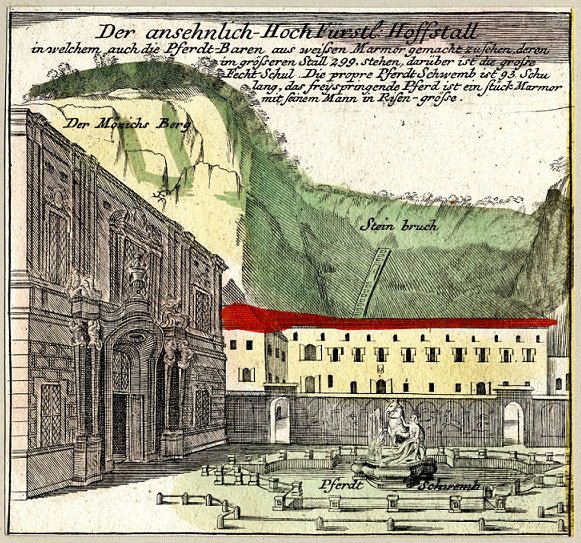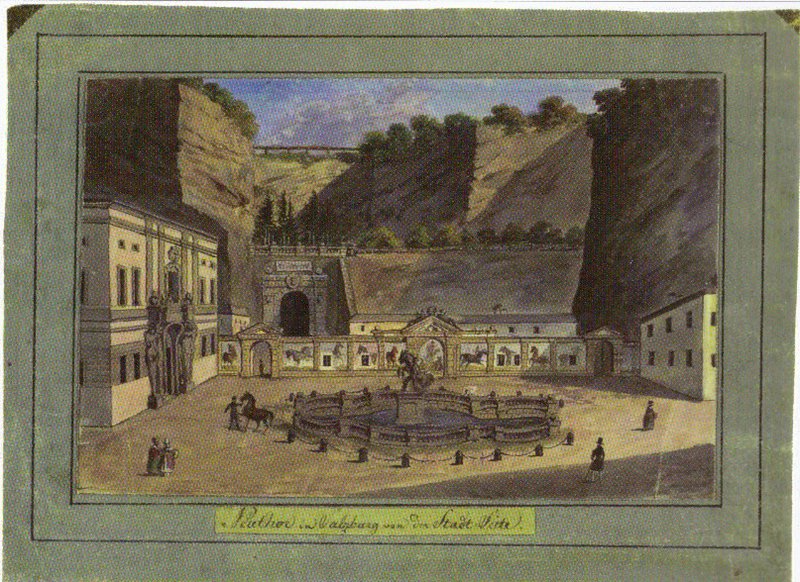
Princely Stables, Salzburg 1740
Also known as the Siegmunds Tor, the 131-meter Neutor was constructed between May 1764 and June 1766 (during the Mozarts' absence from Salzburg) to connect the old city with the Riedenburg suburb on the west side of the Mönchsberg. Designed by Johann Elias von Geyer (1717-Salzburg, 8 October, 1790), it was executed, in part, by the architect Wolfgang Hagenauer (Straβ/Ainring, 16 October 1726-Salzburg, 16 December 1801), brother of Johann Baptist Hagenauer. The Siegmunds Tor opened on 26 June 1766.

Anon, Neutor Salzburg, c1816
- Mozart Relevance
-
Not long after the Mozart family’s arrival in London in the spring of 1764, Leopold heard about the construction of a tunnel through the Mönchsberg that would connect the old town in Salzburg with its suburbs to the west, writing to landlord Johann Lorenz Hagenauer on 8 June 1764:
- The idea of putting a gate next to the Court Stables is an old one, but it’s also a good one and something very beautiful could be done there, although I hope that a French or an English architect will be invited to carry out the work and to do so very soon; indeed, I’d be very keen to see the plans. A French architect would be even better qualified than an English one. I’ve seen many beautiful designs in this regard.
He wrote about the gate again, two years later, on 9 June 1766:
- According to the description that I’ve been given, the entrance to the new gate on the town side isn’t large because the entire wall along the horse bath, where the horses are painted, will remain where it is. I’d imagined that it would be completely different – I’d assumed that the whole wall would be removed and that they’d have tried to position the gate in such a way that on passing through it into the town you would see the fountain directly in front of you and would then be able to turn off to the right or to the left of the fountain. That way it seemed to me freer and more open, as well as being easier to pass round, more attractive and more magnificent. But perhaps it’s better like this. I’m only telling you how I’d previously imagined it.
Leopold's idea for the Neutor probably had its origin in his acquaintance, during the family's travels, with large, open cities, many of them - like Paris (and hence his preference for a French architect) - without city walls. He noted this in his letter of 8 December 1763 from Paris:
- Perhaps you’d like to know what I think of Paris? – – – – – – If I were to give you a detailed account, neither a cowhide nor a rhinoceros hide would be enough for my scrawl. Buy a copy of the Historische Berichte und Praktische Anmerkungen auf Reisen by the Royal Danish Councillor of Justice Peter Willebrandt. It costs 45 kr[euzers] and was published in Frankfurt and Leipzig in 1761. You’ll enjoy it a lot. I’ll say only that Paris is an open city with no gates and that the surroundings are just like a village.
The Neutor, as it was finally constructed and opened in 1766, was built along more traditional lines (see the image above), preserving the sense of a walled city, different from Leopold's more modern ideas concerning urban planning.